Members of InterChange and our allies held a potluck in the Peace Lounge at the Ontario Institute for Studies in Education to collect stories for the Food Peace project. The project features diverse ways food and drink are used to build peace and impact transformative change in our lives, communities, and societies around the world in a social, political, economic, and environmental context. May you embrace peace, health, and happiness through growing, preparing, and sharing food. Read these inspiring stories.
Patrick – Milk
I didn’t bring food to this potluck tonight but I thought I would bring something that has a very important meaning – a symbol of our culture. I’m originally from Rwanda and this icon here represents a traditional scene in Rwanda where you see two people, one person coming to visit another, and the first thing they do is offer the visitors milk.
This is really at the heart of our culture; milk represents a lot. We used to call our country a country of “milk and honey”. When we make our New Year wishes, we wish for the other person to have a year full of milk and honey. Also, you can greet somebody and say “have milk in your life” – these are blessings. So, it’s really central to our culture. The way it relates to peace is that it holds the community together because milk comes from a cow, and people have a tradition of offering a cow to their neighbour. You can have many cows if you can afford them and if you have the space. A lot of time, if somebody does something good for you, you give them a cow and they will give the veal that is born from the cow to another neighbour. Traditionally, you give a cow to a person who has less means. You can give a cow to somebody who has wealth but it’s good to give a cow to somebody who has nothing. So, it’s really part of the culture and it brings so much wealth to the community. I would say that it’s sacred – milk is sacred.
In the image, you can see someone holding something like a jug. It’s made of wood and it’s covered with something like a basket but which is made specifically to cover the milk receptacle. This basket can take a month to make and usually women make them. It’s not very labour intensive but traditionally women make baskets as a stress reliever or just for fun. They make a little bit, put it somewhere, go and do other things in the house, and later come back and do another line. This little cover, which is like a basket, is a symbol of patience. It’s made of sisal and the black part is made of banana bark. That’s what I want to share, the wealth that is in our culture. The wealth is not money; it is what you can give to other people and milk is really central.
Anne – Pink Guava Juice
I did not make anything tonight because I was too busy. But I think that’s part of our life as well. So, I had in my mind that I was going to buy fruit juice from South Africa and that plan didn’t work out all that well either. I was rushing around riding my bike and I thought I’d go to Loblaw’s and get the juice, which they did not have! They do have about four different places in the supermarket where they sell juice – juice that’s refrigerated, juice that’s organic, juice that’s not refrigerated but nowhere was the juice I was going to get.
I remembered that I was coming downtown for a conference so I thought I’d leave it and shop afterwards. When I went afterwards I still couldn’t find it but I found pink guava juice and I thought, whoa! This really reminds me of home.
It actually raised, for me, some questions about local food versus imported food. For example, I love avocados. They are not native to Canada and never will be but other people grow them just to export them. I get excited to see pink guavas in the local city supermarkets like the local store across the road even though I know they didn’t grow locally.
So, I guess part of the question is what “indigeneity” is, and what does it mean? I don’t think it just means “coming from a place.” I think it’s “belonging to a place.” I’m not native to Canada nor are many of us here in this circle, and I feel that that’s part of the richness we bring as well. So, I guess I wonder how this whole tension between local foods and other foods works.
I think growing up in South Africa where we did eat food in season was a definite benefit. Here, you can get a peach any time of the year. But we would look forward so much to the first peach of the spring and you would enjoy it. I feel we have so much abundance that we lack something. We lack that special knowledge that this food is now growing and we forget that things have a natural rhythm. So, partly bringing the pink guava juice is to say that I’m enjoying it even though it’s completely out of its natural rhythm. That’s my story.
Mary Jane – Loaves of Bread
I brought two loaves of bread to the potluck tonight. They were made in my neighbourhood at a local bakery that uses traditional baking methods. It’s a tiny, cubbyhole type place that just recently opened. They have beautiful, rich breads and pastries, and they use organic and traditional methods. It’s very local so it makes you think about the question of local vs. not local food. I work in a community-based agency and we support families but my role is specifically in affordable housing. We have a wonderful agency – the people there get along and we have an incredible team. But I didn’t realize how disconnected we actually were working in our little cubbyholes, our cubicles, until somebody decided that we should have what is called “salad day.” “Salad day” isn’t really about salad – rather it’s one day where everyone brings an item to share and I started to bring this bread regularly. There was a powerful transformation of the group. The way we work together changed because we had shared meals; we were eating with each other as opposed to each individual person going off to a different restaurant or eating at our desks. We still do that – that hasn’t changed – but once a month we have a designated day where everybody brings food to share. I have brought this kind of bread several times now so I wanted to bring it here and share it with everyone as an item of representation for this event. I think it speaks to the peace that we created amongst co-workers. There wasn’t any real conflict to begin with but we created a different environment, we learned about one another in a different way, and we communicated in a different way than we do over our work issues. I think it had a wonderful effect and I was surprised at how much transformation occurred – it was quite remarkable. Also, I think the benefits last throughout the entire month. I just wanted to share the same with all of you.
Natalie – Fish Cakes
I brought a traditional dish from my native homeland of Barbados – fish cakes. It just reminds me of being younger and not growing up in a very diverse community in the suburbs of Mississauga. We always had potlucks to attend. I didn’t cook but my father would cook something really traditional and when everyone placed their food on the table there was always this moment of, “Oh my gosh, are they going to like it? Are they going to make fun of it?” Oftentimes, they did. We weren’t as open or diverse as we are now. So, when I brought this food to the potluck here and people were eating it and enjoying it, there was this feeling of joy and a sense of pride. People started sharing their stories about travelling to Barbados or about liking different foods from Barbados. It was a really great moment. Most Saturdays my dad plays dominoes with his friends, and they cook a traditional dish for which they use pigs’ feet and other parts that people might think are pretty gross. After being involved with this project, I asked my dad about it, and it turns out that during times of slavery those were the only parts of the meat that were available. Now it has become a delicacy. I think this is a great project because as you can see, there are many rippling effects.
Grace – Food, Stories, and Memory
This is not well prepared at all, this story. Maybe like some food that’s not well prepared. For me, food has a very bittersweet feeling. Food can represent plenty, of course, and then when there’s no food or there’s very little food it represents terrible tragedy. For me, as early as I can remember, there was always anxiety around food. My parents were in the Holocaust in WWII – they were in concentration camps. Obviously, they did not have much food at all. Most people around them starved to death. They were fortunate in that they survived but those kinds of wounds – emotional wounds – stay with you even when you can physically eat again, years later. So, when I was a child and we would eat at the table, the interesting thing was that if we would leave something over on the plate, even without necessarily talking about it openly, we knew it was considered a really bad thing to do. I did not have a good appetite when I was a child so there was a lot of anxiety about whether I would be able to finish what was on the plate. When my parents came to Canada after WWII, they had trouble financially and so there was the issue that maybe there would not be enough money to have enough food every month. We wouldn’t starve but it was an issue. So, it took me a long time to find my peace with being able to enjoy food and not feel guilty about it. There was a connection between guilt and enjoying food.
When Patrick mentioned that Rwanda was known as the land of “milk and honey,” it reminded me of how, for the Jews, the “promised land” was called the land of “milk and honey” as well. It got me thinking about the great exodus – Moses bringing the Jewish slaves out of Egypt and wandering the desert for 40 years. And of course, they were in the hot sun and they had very few tools with them so when they made bread it didn’t rise – it was unleavened. I should have brought Matza, which is like a flat sheet of very hard dough. It’s unleavened. At the Passover Seder we are not allowed to eat regular bread. We’re supposed to eat unleavened bread just to remember those who were in the desert who could not eat properly. So, to me food is connected a great deal with memory both positive and negative. It’s about keeping these stories in one’s mind and sharing them with others. There’s a great quote in a book – it’s really sort of a children’s book, which is relevant for here – that stories are sometimes even more important than food to keep you alive. And sometimes you need to share a story with others, which can actually be more important for them than anything, and that’s why I think this project is so important. It occurs to me that the food of humanity is stories. Without stories we’re not human beings. If we stop telling stories what do we have left? I’m still struggling with being able to make food – I don’t cook all that much although I love eating and I love going to other people’s homes to eat. I’m on a journey and perhaps this evening has helped me out with the next stage of that journey.
I did bring baklava tonight, which is the exact opposite of poverty! It’s the exact opposite of scarcity – it is sweet, it is overflowing with flavour, decadent even. It’s something just lovely. I want to end on a hopeful note because that is how I stay alive anyway but I think that I am really on a transformative journey – the fact that I brought baklava, which is beyond sadness – it’s happy.
Christie – Bread & Cheese
My father’s family is Swiss and I lived in Switzerland for a while, a number of years ago when I was younger. I brought bread and cheese to the potluck, which reminds me of my grandparents because they always had bread and cheese for breakfast. In most European countries the big meal is at lunchtime and then bread and cheese is eaten again for supper. My sister and I love that because nobody here wants to eat bread and cheese for breakfast. We also love to eat it for supper but that’s not the norm here. It reminds me, too, of how the actual act of eating and sitting down for dinner is very different between here and Switzerland. When I lived in Switzerland I remember I went with my family out for lunch. We ate lunch, had coffee, had more coffee, sat there for four hours, and then had supper. We were in the restaurant for a total of nine hours. It is a very different mentality about what it’s like to socialize; it’s nothing to go for several hours in the middle of a workday and have something to eat. It’s not necessarily about nourishment but it’s about getting together with people. People, friends, come into restaurants and all start sitting together. The restaurant that I worked in when I lived in Switzerland had a specific table – it was called “stammtisch,” which means “regular table.” It was a round table in the corner that had a little sign, “stammtisch.” If you weren’t a regular or you were a tourist you didn’t sit there. There would always be a bunch of old guys sitting at the table drinking coffee. That’s where the regulars sat. If you go into any restaurant in the central part of Switzerland where I lived and worked, you’d find a stammtisch. It was funny when I travelled with my cousins; I sat at the stammtisch because I was a “regular” when I was with them. The idea is that it’s not so much about what you’re eating as it is about socializing. The concept of time in Switzerland is very different than in North America. I try to get my friends here to go out for dinner and it’s always a big deal about where we go. I honestly don’t care where we go. I also eat really slowly, which annoys them but they want to leave as soon as they’re done eating. For me, I want a whole evening out – I have no problem spending four or five hours in a restaurant. So, not only does the bread and cheese remind me of my grandmother but it reminds me of “the old country” as my grandma would say, and a very different way of life.
Kim – Black Bean and Rice Salad
Feeding bellies feeds souls.
I have always liked cooking and sharing new discoveries with friends and colleagues. Much of my work has also involved helping folks to explore food that gives the biggest nutritional bang for their buck. I have been vegetarian for years and avoid foods that are processed and laden with chemicals. I believe that factory farms and big box stores are bad for bodies, bad for the earth, and ultimately will create catastrophic changes in weather patterns. We are already seeing wide spread health crises in areas where food is abundant while poverty and malnutrition continue to plague developing nations.
Recipes should be easy and flexible. Rice and grain dishes are found the world over. Plant-based diets are peace-based diets – kind to the environment and good for our bodies. This recipe is a happy blend of some of my favourite foods. The juicy acidity of the limes and the bitter warmth of the cumin beautifully enhance the protein in the rice and beans. The buttery goodness of the avocado is a great balance to the bitter arugula that jump-starts your system after a long winter of heavy foods.
Sharing food that is prepared with care opens hearts, encourages connections, and creates endless possibilities. Our gathering to share food is like creating the food itself. A number of ones combined together creates a new whole that fills and nourishes bodies and souls.
Black Bean and Brown Rice Salad
Ingredients:
- 1 cup of cooked brown rice
- 1 tin black beans, rinsed well
- 1 avocado, diced
- 1 tomato, diced
- 1 lime, juiced
- 1 tbsp cumin, ground
- ½ tsp sea salt
- 1 small box of arugula
- Optional – ground pepper, hot sauce, chopped cilantro
Preparation:
Gently mix all of the ingredients together. Serve on a bed of arugula. Feel free to adjust quantities of any of the ingredients to taste and availability. Enjoy!
Crystal – Apple Crisp
Every year, my mother would make a popular Canadian dessert, apple crisp, for our family get-togethers at Thanksgiving, Christmas, and Easter. She could never miss a year or else my family would complain and ask why on earth she hadn’t remade the apple crisp for that occasion. In my family’s opinion, my mom’s apple crisp is the best. I’ve been eating the stuff since I was a small child and it’s still one of my favourite desserts of all time. I remember that when my mother had to bring the dessert to a relative’s house, my brother and I would try to sneak bits of the sugary, crispy part off the top of the apples. My mother would scold us playfully, reminding us that we should not touch the dessert until later in the evening. More recently, she told me that although she had to pretend to be strict with us about not eating the dessert before it made it to my relative’s house, she secretly enjoyed being able to give us a treat that we truly loved.
I have begun to make apple crisp for the gatherings that I attend with my friends and the tradition continues: my mom’s apple crisp is always a hit. I like baking it –the smell fills the house of sugar, apples, and cinnamon, and your mouth begins to water as you anxiously await the moment when the oven timer lets you know that you can finally take a bite of the delicious crisp.
I think this crisp is important to our family and to me when I bring it to my own gatherings. It pulls people together, it is the beginning of a conversation, and it is a tradition baked up in the form of cooked apples and crispy sugar, cinnamon, nutmeg, and flour. It is also a point of connection for me and my mother.
At first I coveted this recipe: I wanted to be the one who could make this simple, delightful dish and bring it to potlucks as a dessert hero. However, I have begun to take on the idea of share and share alike. I don’t want to keep this recipe to myself – it’s too good, and there are others who may really enjoy this dessert that may not get a chance to taste it, otherwise. So, I have begun to send the recipe to my friends and coworkers when they need a new dessert recipe or when they ask for the recipe to my mom’s apple crisp after trying it. In this way apple crisp builds peace and community. It brings people together, and it has allowed me to let go of my own pride and to entrust my family tradition with others who I know well or who I don’t know at all. It makes more sense if we can all share and enjoy this treat in kitchens with friends around the world.
Apple Crisp from Crystal and her mother, Kathy, to you.
Ingredients:
- 4 cups of sliced apples or one 1-pound 2-ounce can pie-sliced apples, drained (or you can put in a little more)
- About ¼ cup orange juice (this is the secret ingredient!)
- ¾ cup all-purpose flour
- 1 cup sugar
- ½ teaspoon ground cinnamon
- ¼ teaspoon ground nutmeg
- ½ cup (melted) butter
Preparation:
First, pile the apples in a 9 inch buttered pie plate, and then sprinkle them with orange juice. After this, you must combine and mix the flour, sugar, spices and a dash of salt (this is optional). Next, you must cut in the butter until the mixture becomes crumbly; sprinkle this mixture over the apples.
Bake the dessert at 375 degrees for 45 minutes or until the apples are tender and the topping is crisp. You can serve it warm with cream. This apple crisp serves about 6. Enjoy!
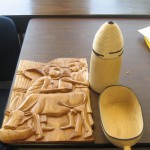
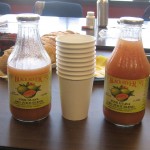
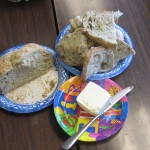
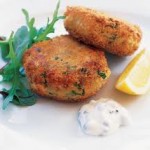

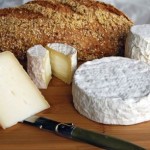
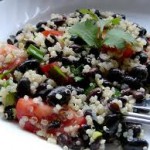
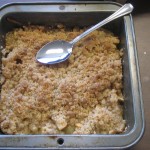

Recent Comments